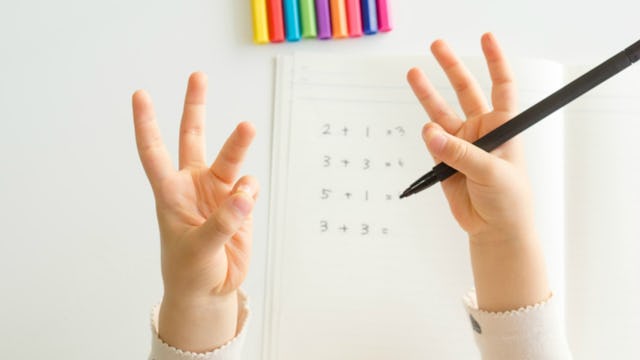Why Kids Of All Ages Should Use Their Fingers During Math Class

I remember it like it was last week. I was in second grade, my first week at my brand new school, sitting at my desk working on a two digit addition problem (you know, the kind with carrying and all that). I began adding the first column of numbers with my fingers, as I’d always done.
Just then, my teacher walked by me, saw that I was counting on my fingers, and scolded me.
“Never count on your fingers,” she instructed. “Do it in your head.”
Well, I couldn’t do it in my head. And when I tried to picture the numbers in my head, I saw my fingers anyway. So, like many students, I hid my fingers on my lap, under my desk, and did my computations that way. I was a star math student (well, that is, until trigonometry, but that’s a different story).
It turns out that I was not alone. Many young students use their fingers to compute math problems. And although many teachers still discourage it, research proves that counting on your fingers is fine and normal – and actually is a preferred method of computation.
Yep, doing math on your fingers actually makes you better at math, according to research. Who knew?
As Jo Boaler, professor at Stanford University, and Lang Chen, postdoctoral research fellow in psychiatry at the Stanford School of Medicine, explain in The Atlantic: “Evidence from both behavioral and neuroscience studies shows that when people receive training on ways to perceive and represent their own fingers, they get better at doing so, which leads to higher mathematics achievement.”
Nice, right?
The authors cite several pieces of research to prove this point, including one study from 2015 that shows there is actually a specific area of our brain dedicated to the “perception and representation of fingers.” Yay! This area is called the “somatosensory finger area” and researchers say that even when we are not using our fingers to calculate, we “see” our fingers in our brains.
“The researchers found that when 8-to-13-year-olds were given complex subtraction problems, the somatosensory finger area lit up, even though the students did not use their fingers,” the authors explain. “This finger-representation area was, according to their study, also engaged to a greater extent with more complex problems that involved higher numbers and more manipulation.”
Totally fascinating – and absolutely vindicating to those of us who relied on our fingers to count. Turns out, we were normal all along. Sheesh.
Still, other research has found that kids who use their fingers to count are actually more competent at math.
“[T]he better students’ knowledge of their fingers was in the first grade, the higher they scored on number comparison and estimation in the second grade,” explain the authors. “Even university students’ finger perception predicted their calculation scores.”
Damn. I want to find my second grade teacher and send this stuff to her.
Part of the reason that finger counting is so common and normal is because math is actually a very visual thing, Boaler and Chen say. But it’s only been in recent years that experts in math education have caught up with this fact (say what you want about common core, but it does emphasize the visual aspects of math at least a little more than older math systems did).
“Fingers are probably one of our most useful visual aids, and the finger area of our brain is used well into adulthood,” the authors say, adding the warning that preventing kids from using their fingers during mathematical computations could “be akin to halting their mathematical development.”
Hear that? Let kids use their fingers. Please.
Listen, I’m sure there are some kids out there who don’t need to rely on their fingers to do math. My older son can do every freaking thing in his head and I don’t understand him at all. But the majority of us have a very well developed “somatosensory finger area” in our brain – and dammit, we’re going to use it.
In fact, I still use my fingers to count, and I’m 40 years old. And now I can finally stop feeling like a slacker for doing so. Turns out, I’m a dang genius.
This article was originally published on